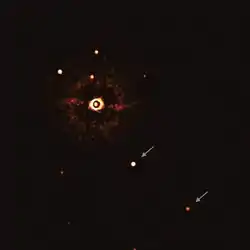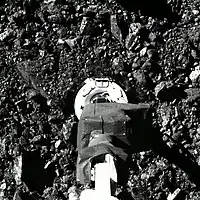TYC 8998-760-1
TYC 8998-760-1 is a young star, about 17 Ma old, located 310 light years away in the constellation of Musca, with a mass 1.00±0.02 times the Sun.
| Observation data Epoch J2000 Equinox J2000 | |
|---|---|
| Constellation | Musca |
| Right ascension | 13h 25m 12.1263s[2] |
| Declination | −64° 56′ 20.689″[2] |
| Apparent magnitude (V) | 11.19[3] |
| Characteristics | |
| Evolutionary stage | Pre-main sequence[4] |
| Spectral type | K3IV[5] |
| Astrometry | |
| Radial velocity (Rv) | 12.84[6] km/s |
| Proper motion (μ) | RA: −40.996[2] mas/yr Dec.: −17.734[2] mas/yr |
| Parallax (π) | 10.6124 ± 0.0116 mas[2] |
| Distance | 307.3 ± 0.3 ly (94.2 ± 0.1 pc) |
| Details | |
| Mass | 1.00[4] M☉ |
| Radius | 1.01[2] R☉ |
| Luminosity | 0.508[2] L☉ |
| Surface gravity (log g) | 4.4[2] cgs |
| Temperature | 4,862[2] K |
| Age | 17[4] Myr |
| Database references | |
| SIMBAD | data |
Planetary system
There are two giant exoplanets orbiting the star. The European Southern Observatory's Very Large Telescope photographed the two planets using its SPHERE instrument, producing the first direct image of multiple planets orbiting a Sun-like star.[1][7]
| Companion (in order from star) |
Mass | Semimajor axis (AU) |
Orbital period (years) |
Eccentricity | Inclination | Radius |
|---|---|---|---|---|---|---|
| b | 14±3 MJ | 162 | 4500 (assuming e = 0) |
— | — | 3.0+0.2 −0.7 RJ |
| c | 6±1 MJ | 320 | 5700 (assuming e = 0) |
— | — | 1.1+0.6 −0.3 RJ |
TYC 8998-760-1 b is a gas giant exoplanet which has a mass 14 times that of Jupiter, and a radius of 3 RJ. It orbits at a distance of 162 AU (2.42×1010 km; 1.51×1010 mi), or slightly more than 5 times the Neptune-Sun distance.[4][9] In July 2021, astronomers reported the detection, for the first time, of an isotope in the atmosphere of an exoplanet; more specifically, the isotope Carbon-13 (C13) was found in the atmosphere.[10][11]
TYC 8998-760-1 c is a gas giant exoplanet which has a mass of 6 MJ, and orbits at 320 AU (4.8×1010 km; 3.0×1010 mi), or slightly more than 11 times the Neptune-Sun distance.[4]
References
- ESO/Bohn (22 July 2020). "First ever image of a multi-planet system around a Sun-like star (uncropped, with annotations)". ESO. European Southern Observatory. Archived from the original on 24 July 2020. Retrieved 24 July 2020.
- Vallenari, A.; et al. (Gaia Collaboration) (2022). "Gaia Data Release 3. Summary of the content and survey properties". Astronomy & Astrophysics. arXiv:2208.00211. doi:10.1051/0004-6361/202243940. Gaia DR3 record for this source at VizieR.
- Høg, E.; et al. (2000). "The Tycho-2 catalogue of the 2.5 million brightest stars". Astronomy and Astrophysics. 355: L27–L30. Bibcode:2000A&A...355L..27H.
- Bohn, Alexander (22 July 2020). "Two Directly Imaged, Wide-orbit Giant Planets around the Young, Solar Analog TYC 8998-760-1". The Astrophysical Journal Letters. 898 (1): L16. arXiv:2007.10991. Bibcode:2020ApJ...898L..16B. doi:10.3847/2041-8213/aba27e. S2CID 220686536.
- "TYC 8998-760-1". SIMBAD. Centre de données astronomiques de Strasbourg. Retrieved 22 July 2020.
- Brown, A. G. A.; et al. (Gaia collaboration) (August 2018). "Gaia Data Release 2: Summary of the contents and survey properties". Astronomy & Astrophysics. 616. A1. arXiv:1804.09365. Bibcode:2018A&A...616A...1G. doi:10.1051/0004-6361/201833051. Gaia DR2 record for this source at VizieR.
- Wall, Mike (22 July 2020). "Multiplanet system around sunlike star photographed for 1st time ever - The two newly imaged planets are huge — 14 and 6 times more massive than Jupiter". Space.com. Retrieved 22 July 2020.
- Planet TYC 8998-760-1 b at exoplanets.eu
- "Astronomers Directly Image Two Giant Exoplanets around Young Sun-Like Star | Astronomy | Sci-News.com". Breaking Science News | Sci-News.com. Retrieved 2020-07-25.
- Starr, Michelle (14 July 2021). "Isotopes Detected in The Atmosphere of an Exoplanet For The First Time". ScienceAlert. Retrieved 14 July 2021.
- Zhang, Yapeng; et al. (14 July 2021). "The 13CO-rich atmosphere of a young accreting super-Jupiter". Nature. 595 (7867): 370–372. arXiv:2107.06297. doi:10.1038/s41586-021-03616-x. ISSN 0028-0836. PMID 34262209. S2CID 235829633. Retrieved 14 July 2021.



_on_Jul_14_2020_aligned_to_stars.jpg.webp)